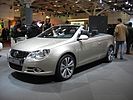Convertible
A convertible or cabriolet (/ˌkæbrioʊˈleɪ/) is a passenger car that can be driven with or without a roof in place. The methods of retracting and storing the roof vary among eras and manufacturers.
A convertible car's design allows an open-air driving experience, with the ability to provide a roof when required. A potential drawback of convertibles is their reduced structural rigidity (requiring significant engineering and modification to counteract the effects of removing a car's roof).[2][3]
The majority of convertible roofs are of a folding construction framework with the actual top made from cloth or other fabric. Other types of convertible roofs include retractable hardtops (often constructed from metal or plastic) and detachable hardtops (where a metal or plastic roof is manually removed and often stored in the trunk).
Terminology
Other terms for convertibles include cabriolet, cabrio, drop top, drophead coupé, open two-seater, open top, rag top, soft top, spider, and spyder. Consistency is rare about the current use of cabriolet in preference to convertible.[4] The term cabriolet originated from a carriage cabriolet: "a light, two-wheeled, one-horse carriage with a folding top, capable of seating two persons"; however, the term is also used to describe other convertibles.[5]
In the United Kingdom, the historical term for a two-door convertible is drophead coupé, and a four-door convertible was called an
History

Most of the early automobiles were open-air vehicles without any roof or sides.[7][8][9][10] As car engines became more powerful by the end of the 19th century, folding textile or leather roofs (as had been used on victoria or landau carriages) began to appear on cars.[11][12] Examples of early cars with roofs include the phaeton (a two-seat car with a temporary roof), the brougham or a coupé de ville, having an enclosed passenger compartment at the rear, while the driver sat in front either in the open, or the landaulet, where the driver has a fixed roof and the passenger compartment has a folding roof. Less expensive cars, such as the runabouts, sporting roadsters, or sturdy touring cars, remained either completely open air or were fitted with a rudimentary folding top and detachable clear side curtains.
In the 1920s, when steel bodies began to be mass-produced, closed cars became available to the average buyer, and fully open cars began to disappear from the mainstream market.[13] By the mid 1930s, the remaining small number of convertibles sold were high-priced luxury models.[12] In 1939, Plymouth introduced the first mechanically operated convertible roof powered by two vacuum cylinders.[14][15]
Demand for convertibles increased as a result of American soldiers in France and the United Kingdom during World War 2 experiencing the small roadster cars that were not available in the United States at the time.[13] These roadsters included the MG Midget and Triumph Roadster. The convertible design was incorporated into the mass market unibody by Hudson in 1948.[16][17] United States automakers manufactured a broad range of convertible models during the 1950s and 1960s – from economical compact-sized models such as the Rambler American[18] and the Studebaker Lark, to the more expensive models, such as the Packard Caribbean, Oldsmobile 98, and Imperial by Chrysler.[19] Automakers often included a convertible body style as an available body style in a model range.[20][21][22]
Convertibles in the U.S. market reached a sales peak in 1965 and fell in popularity over the next five years.[23] Optional air conditioning became more popular and the availability of sunroofs and T-tops limited the appeal of the open body style as well as the noise, leaks, and repairs associated with fabric tops.[23] The popularity of convertibles was reduced by the increased travel speeds on roads (resulting in more wind and noise for occupants) and proposed vehicle crash safety standards in the United States.[13][24]
The market share of convertibles fell to two or three percent of total sales and the U.S. automakers discontinued the body style from their lineups.[23] American Motors stopped making convertibles after the 1968 model year, Chrysler after 1971, Ford after 1973, and most divisions of General Motors after 1975. Cadillac held out until 1976, when they made about 14,000. The last 200 had a red, white, and blue motif and a dashboard plaque. The very last was offered to the Smithsonian Institution, whose trustees turned it down as it was not at that moment a historic artifact, "Though it might well be in three generations ... or at the Tricentennial."[25] After the last Cadillac Eldorado convertible was made in 1976, the only factory convertibles sold in the United States were imported. Making convertibles on the assembly line was both expensive and time-consuming, thus not worth the problems needed to sell the limited number of cars.[23]


Specialized coachbuilders were contracted to make dealer-available cars such as the
In 1989, Mazda released the first generation Mazda MX-5 (called "Miata" in North America), which has become the best-selling convertible with over 1 million cars sold.[32] Also in 1989, Toyota released the Toyota Soarer Aerocabin, which uses an electrically operated retractable hardtop roof.[33] A total of 500 were produced.[34]
Models dedicated to the convertible body style include the
Roof types
Textile

A "soft top" is made from a flexible textile material:
- Early convertibles used cotton canvas woven so tightly that it was waterproof. Automakers had problems in securing raw materials to fulfill orders after World War II, including canvas in various shades for convertible tops, therefore limiting their manufacture.[36]
- A cloth-based material has become more common in recent years.[37]
Other materials are also used in the convertible top. By 1955, the most popular materials were
The collapsible textile roof section over an articulated folding frame may include linings such as a sound-deadening layer and/or an interior cosmetic lining, to hide the frame.
The folded convertible mechanism with the top is called the stack.[39] Designs that fold down to a lower stack height offer a smoother silhouette for the car with the top down while concealed side rails allow room for three passengers in the back seat such as on the 1967 Rambler Rebel convertible.[40]
Detachable hardtop
Rigid removable hardtops, many of which can be stored in a car's trunk/boot, have been available at least since the 1950s.
During the 1950s and 1960s, detachable hard-material roofs were offered for various
The metal-framed "Carson top" was a popular addition for the 1930s Ford convertibles or roadsters because it turned these models into an almost instant hardtop.[41] The design mimicked a convertible top, but lacking the bulky folding mechanisms enabled the removable hardtop to have a much lower and more rakish profile.[43]
Improvements in canvas tops have rendered the detachable hard roof less common in part because the top cannot be stored inside the vehicle when not in use, requiring a garage or other storage facility. Some open cars continue to offer it as an option. For example, the Mazda MX-5 has an accessory hardtop, which is compulsory for some auto racing series.
Retractable hardtop

A retractable hardtop — also known as "coupé convertible" or "coupé cabriolet" — is a car with an automatically operated, self-storing hardtop (as opposed to the textile-based roof used by traditional convertibles).
The benefits of improved climate control and security are traded off against increased mechanical complexity, cost, weight, and often reduced luggage capacity.[citation needed]
Other design features
Tonneau cover
Folding textile convertible tops often fail to completely hide their internal mechanism or can expose their vulnerable underside to sun exposure and fading. A tonneau cover provides a solution.
Rear window
Rear windows are often part of the roof assembly. Traditionally, the rear window in a soft-top was made from plastic; however, more recently some convertibles have used glass for the rear window.[44]
Windblocker
A windblocker or wind deflector minimizes noise and rushing air reaching the occupants.
Several convertibles are available with a heating duct to the neck area of the seat, which is often called an "Air Scarf". Examples of cars with this feature include Mercedes-Benz SLK-Class, Mercedes-Benz SL-Class, and Audi A5/S5.
Safety
Modern safety features specifically for convertibles include:
- roll hoopshidden behind the rear seats that deploy under rollover conditions
- heated rear window (for improved visibility)
- A-pillars
- safety cage construction – a horseshoe-like structure around the passenger compartment
- door-mounted side-impact airbag which inflates upward (instead of downward like the typical curtain airbag) to provide head protection even with an open window[47]
Variations
Convertibles have offered numerous iterations that fall between the first mechanically simple fabric tops to complex retractable roofs made from hard materials:
Roadster: A roadster (also called spider or spyder) is an open two-seat car with emphasis on sporting appearance or character. Initially, an American term for a two-seat car with no weather protection, usage has spread internationally and has evolved to include two-seat convertibles.
Cabrio coach: A
An advantage of a cabrio coach is that retaining more of the car's original structure means that structural rigidity is higher (or the vehicle weight is lower) than traditional cabriolets.[48] An example of the cabrio coach is the 2003-10 C3 Pluriel,[48] which has a roof with five possible configurations.[49][50]

Fixed-profile: In contrast to convertibles where the entire bodywork above the beltline (doors, roof, side pillars, side bodywork) is replaced with a folding or retractable roof, the fixed profile convertible retains portions of fixed bodywork including the doors, side pillars, and side elements of the roof — while a center fabric portion slides back and accordions at the rear. As an example,
Four-door: Most convertibles have two doors. However, four-door convertibles have been mass-produced. Examples include the 1940-41 Cadillac Series 62, 1931 Chrysler Imperial Dual Cowl Phaeton and 1961-67 Lincoln Continental.[51] Current production four-door convertibles include the Jeep Wrangler Unlimited.[52][53]
Peugeot presented a concept four-door retractable hardtop convertible, the Peugeot 407 Macarena in 2006.[54] Produced by French coachbuilding specialist Heuliez, the Macarena's top can be folded in 60 seconds,[54] with a steel reinforcing beam behind the front seats incorporating LCD screens for the rear passengers into the crossmember.[54]
Off-road: Several off-road vehicles have been produced with removable soft tops.[55] Examples include the Jeep Wrangler, Suzuki Vitara, Suzuki Jimny,[56] Ford Bronco, Land Rover Defender, Mercedes-Benz G-Class[57] as well as early models of the Toyota Land Cruiser and Land Rover Defender. Typically, the soft tops attach to the roll cage or to the installation points on the vehicle's body.
Landaulet: A
In the second half of the 20th century, landaulets were used by public figures (such as heads of state) in formal processions. They are now rarely used, for fear of terrorist attacks.
Victoria-Cabriolet: reminiscent of the victoria carriage style, a three-position convertible. No rear side windows and equipped with a soft top that can be raised partway, leaving the area above the front seats folded back.[61] This body style had a short period of popularity, mainly in the 1930s. Other names include Cabriolet/Coupé Milord (or just Milord), Calash (from Calèche), Folding Head DHC, three-position Drop-head Coupé, or Cabriolet toit de 3 positions.[62]
Gallery
Open car and roadster
-
Ford Model T circa 1925, with minimal weather protection
-
Bentley 4½ Litre 1929 with luxury snap-on and thumbscrew side screens
-
Aero 500 from 1929
-
Ford Phaeton 1934open four-door touring car
-
1937 Delahaye 135MS Roadster
-
MG TD circa 1953, with manual soft top and detachable side screens with plastic windows
-
Lancia D23 Spyder 1953
-
1955 Porsche 550 Spyder
Convertibles
-
1936 Packard One-Twenty Convertible Victoria with the top in the semi-open (second) position
-
Fixed-profile circa 1950 Nash Rambler Convertible "Landau" Coupe[63]
-
Škoda 450 from 1957
-
Mercedes-Benz 300d landaulet in operation
-
Škoda Felicia from 1959
-
Lincoln Continental circa 1962, four-door with automatic, self-storing tonneau
-
Jaguar E-type1963, with vinyl foldable tonneau installed and snap-secured
-
Mercedes SL 1964, available with a detachable hardtop
-
1966 Rolls-Royce Phantom V landaulet
-
Cadillac Eldorado 1972, with detachable, two-part, fully rigid "parade boot" tonneau cover
-
Citroën 2CV fixed profile convertible circa 1975, with roll-back roof and rigid doors
-
ZIL-410441 parading on Victory Day 2011.
-
Rolls Royce Cornichecirca 1986, with a manually installed tonneau cover
-
Cadillac Allanté circa 1993, with detachable, rigid plastic tonneau cover
-
Volkswagen New Beetle circa 2003, with raised textile top
-
Porsche Boxster circa 2004, with detachable clear plastic windblocker and a Z-fold top[64]
-
Citroën C3 Pluriel circa 2007 with roll-back textile roof and removable rigid sidebars[49]
-
A Fiat 500 (2007) fixed-profile convertible
-
Jaguar XK circa 2008, with heatable glass rear window and fully automatic cloth top
Retractable hardtop
-
Daihatsu Copen circa 2001 with retracted hardtop, kei class
-
Chevrolet SSR circa 2004, a retractable hardtop convertible pickup truck
-
Ford Focus CCcirca 2006 with its roof retracted
-
Cadillac XLR circa 2007, with aluminum hardtop concealed by tonneau cover
-
Volkswagen Eos circa 2007 with five-segment top and independent sunroof
See also
References
- ^ "Hudson Hornet Generation I Convertible". Rīgas Meistardarbnīca. 2015. Retrieved 25 June 2022.
- ^ Garrett, Jerry (8 October 2006). "2007 Volkswagen Eos: In Praise of a Convertible Goddess". The New York Times. Retrieved 6 March 2011.
- ^ "What You Should Know Before Buying a Convertible". Edmunds. Retrieved 6 March 2011.
- ^ "Convertible and Cabriolet what's the difference?". Convertible Car Magazine. 31 December 2016. Retrieved 10 March 2022.
- ^ "Definition: Cabriolet". dictionary.com. Retrieved 10 March 2022.
- ISBN 0854292179.
- ^ "Beginnings of the automobile: the predecessor companies (1886-1920)". daimler.com. Retrieved 14 April 2018.
- ^ "British Motor Manufacturers (1894-1960), Arnold". britishmm.co.uk. Archived from the original on 16 June 2011.
- ^ "Early American Automobiles Pre 1900". earlyamericanautomobiles.com. Retrieved 14 April 2018.
- ^ "Hurtu". gracesguide.co.uk. Retrieved 14 April 2018.
- ^ "The Evolution of the Convertible- slide 2". popularmechanics.com. 25 June 2012. Retrieved 14 April 2018.
- ^ a b "A brief history of the convertible". autofocus.ca. Archived from the original on 14 September 2018. Retrieved 14 April 2018.
- ^ a b c "The up-and-down history of the convertible". cbsnews.com. 13 July 2014. Retrieved 14 April 2018.
- ^ "The Evolution of the Convertible- slide 5". popularmechanics.com. 25 June 2012. Retrieved 14 April 2018.
- ^ "The Deluxe Plymouth for 1939 (brochure)" (PDF). p. 15. Retrieved 26 December 2022 – via xr793.com.
- ^ Lewis, Corey (7 March 2019). "Rare Rides: A Hudson Commodore Brougham From 1950, Complete With Celebrity Ownership". thetruthaboutcars.com. Retrieved 26 December 2022.
- ^ Salmi, Steve (11 February 2022). "1948 Hudson 'step-down' was a brilliant car with tragic flaws". Indie Auto. Retrieved 26 December 2022.
- ^ "All new! A convertible with Rambler Excellence (advertisement)". Life. Vol. 50, no. 22. 2 June 1962. Retrieved 26 December 2022 – via Google Books.
- ISBN 9781845842390. Retrieved 26 December 2022 – via Google Books.
- ^ "1967 Rambler Rebel brochure". oldcarbrochures.org. p. 13. Retrieved 10 March 2022.
- ^ LaChance, Dave (July 2006). "Daytona Delight - 1964 Studebaker Daytona". Hemmings Classic Car. Retrieved 26 December 2022.
- ISBN 9781610591324. Retrieved 26 December 2022 – via Google Books.
- ^ a b c d e Hunting, Benjamin (15 February 2022). "How ASC brought convertibles back from the dead". Hagerty. Retrieved 26 December 2022.
- ^ "The Evolution of the Convertible- slide 8". popularmechanics.com. 25 June 2012. Retrieved 14 April 2018.
- ^ Lynton, Stephen (6 April 1976). "The gilt edged Cadillac". The Guardian. p. 4.
- ^ Niedermeyer, Paul (24 January 2014). "The AMC I Forgot About: Sundancer – The Only Way To Top A Concord Or Eagle". Curbside Classic. Retrieved 26 December 2022.
- ^ ODonnell, Jim (27 November 2020). "Rare SunChaser! 1980 Toyota Celica Convertible". Barn Finds. Retrieved 26 December 2022.
- ^ Holusha, John (2 March 1981). "The U.S. Convertible Making a Comeback". The New York Times. Retrieved 14 August 2019.
- ^ "The K Car: Variations on a Theme Helped to Save Chrysler". The New York Times. 29 January 1984. Retrieved 14 August 2019.
- ISBN 9781610591089. Retrieved 26 December 2022 – via Google Books.
- ^ Ross, Daniel Charles (October 1984). "AMC's Sunny Side Up". Popular Mechanics. Vol. 161, no. 10. p. 99. Retrieved 26 December 2022 – via Google Books.
- ^ "Mazda builds 1 millionth MX-5". autoblog.com. Retrieved 14 April 2018.
- ^ "A Soarer Aerocabin Found In LA". speedhunters.com. June 2015. Retrieved 14 April 2018.
- ^ "This One Of 500 Toyota Soarer Aerocabin Can Be Yours". carscoops.com. 21 September 2016. Retrieved 14 April 2018.
- ^ "2019 Buick Cascada Buyer's Guide". MotorTrend. Retrieved 25 June 2022.
- ^ "The Last Roadster". Cars and Parts. Vol. 43. 2000. p. 42. Retrieved 26 December 2022 – via Google Books.
- ISBN 9781932494983. Retrieved 26 December 2022 – via Google Books.
- ^ Jacobs, Milton (1957). Fabrics and Fibers for Passenger Cars: Automobile Manufacturers' Views, 1955 Compared with 1950, Issue 152 of Marketing research report. U.S. Department of Agriculture, Agricultural Marketing Service, Marketing Research Division. pp. 8, 40–41. Retrieved 26 December 2022 – via Google Books.
- ^ Powell, James C. (25 April 2006). "Convertible vehicle top stack mechanism". freepatentsonline.com. Retrieved 26 December 2022.
- ^ "1967 AMC Data Book - Rambler Rebel convertible". oldcarbrochures.org. p. 34. Retrieved 26 December 2022.
- ^ a b Howley, Tim (April 2006). "A History of Hardtops". Hemmings Classic Car. Hemmings Motor News. Retrieved 26 December 2022.
- ^ "356 Porsche Removable Hardtops". derwhites356literature.com. Retrieved 15 April 2018.
- ^ "Pisano/Ogden Buick: Profile of a Custom Car". howstuffworks.com. 19 September 2007. Archived from the original on 29 November 2020. Retrieved 10 March 2022.
- ^ "Convertible Buying Guide". consumerreports.org. Retrieved 29 April 2018.
- ^ "Convertible buying info: Top-down driving". edmunds.com. Retrieved 29 April 2018.
- ^ "2008 Chrysler Sebring Convertible's Solid Structure and Systems Deliver Smooth Driving, Tight Handling and a Quiet Ride". Chrysler Group (Press release). 30 March 2007. Archived from the original on 13 October 2012. Retrieved 10 March 2022 – via prnewswire.
- ^ "Volvo C70 - safety, the next generation". autoblog.com.
- ^ a b "The Semi-Convertible or Cabrio Coach: It's About Being Chic and Strong at the Same Time". autoevolution.com. 15 April 2015. Retrieved 5 April 2018.
- ^ a b "Citroen C3 Pluriel (2003–) Review". Archived from the original on 5 November 2007.
- ^ "Citroen C3 Pluriel". honestjohn.co.uk. 28 May 2003. Archived from the original on 12 January 2010. Retrieved 3 February 2014.
- ISBN 9780785324355.
- ^ "Jeep history in the 2000s". jeep.com. Retrieved 8 May 2018.
- ^ "2017 Jeep Wrangler". edmunds.com. Retrieved 8 May 2018.
- ^ a b c "¡Hey, Macarena! Heuliez Creates an Open-Top Peugeot 407". Edmunds. 18 January 2006. Archived from the original on 19 December 2006. Retrieved 25 June 2022.
- ^ "Evolution Of The Convertible SUV". autowise.com. March 2018. Retrieved 8 May 2018.
- ^ "Suzuki Jimny 2005 - 2012". autoevolution.com. Retrieved 8 May 2018.
- ^ "2018 Mercedes-Maybach G650 Landaulet". caranddriver.com. 12 February 2017. Retrieved 8 May 2018.
- ISBN 978-1-57958-367-5.
- ^ LCCN 13003001. Retrieved 1 September 2014.
- LCCN 91029965. Retrieved 25 June 2022.
The motor landaulet was essentially an enclosed sedan or coupe with a folding top at the extreme rear quarter, over the rear seat.
- ISBN 9780786499182, retrieved 25 June 2022 – via Google Books
- ^ Haajanen, p. 35
- ^ Niedermeyer, Paul (25 January 2021). "Junkyard ClassicMiat/Automotive History: 1955 Rambler Cross Country – How Rambler Won The Compact And Price Wars Of The 1950's And Saved AMC". Curbside Classic. Retrieved 25 June 2022.
- ^ "2007 Porsche Boxster". conceptcarz.com. Retrieved 6 March 2011.
- ^ Vaughn, Mark (10 September 2006). "2007 Mazda MX-5 Miata Power Retractable Hardtop". Autoweek. Archived from the original on 4 June 2011. Retrieved 6 March 2011.
Further reading
- Adler, Dennis (2011). Convertibles. First Gear series. Minneapolis, MN: Motorbooks. ISBN 9780760340202.
- Hirsch, Jay; Weith, Warren (1979). The Last American Convertibles. New York: Collier Books; London: Collier Macmillan. ISBN 0-02-080010-X.
- Holmes, Mark (2007). Ultimate Convertibles: Roofless Beauty. London: Kandour. ISBN 978-1-905741-62-5.
- Langworth, Richard M (1988). The Great American Convertible. New York: Beekman House. ISBN 0-517-65581-0.
- Wieder, Robert; Hall, George (1977). The Great American Convertible: An Affectionate Guide. Garden City, NY: Doubleday. ISBN 0-385-13123-2.









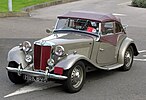



![Fixed-profile circa 1950 Nash Rambler Convertible "Landau" Coupe[63]](http://upload.wikimedia.org/wikipedia/commons/thumb/3/3e/1950-nash-001.jpg/150px-1950-nash-001.jpg)

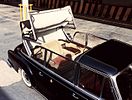

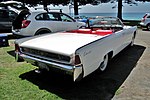









![Porsche Boxster circa 2004, with detachable clear plastic windblocker and a Z-fold top[64]](http://upload.wikimedia.org/wikipedia/commons/thumb/5/5d/Porsche_Boxster_hr_silver.jpg/163px-Porsche_Boxster_hr_silver.jpg)
![Citroën C3 Pluriel circa 2007 with roll-back textile roof and removable rigid sidebars[49]](http://upload.wikimedia.org/wikipedia/commons/thumb/b/bf/Citroen_C3_Pluriel_rear_20071104.jpg/134px-Citroen_C3_Pluriel_rear_20071104.jpg)
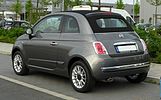

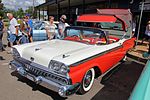
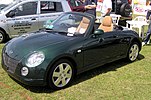
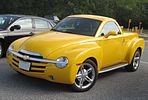

![Mazda MX-5 circa 2007, with polycarbonate hardtop[65]](http://upload.wikimedia.org/wikipedia/commons/thumb/c/c4/Mazda_MX-5_hardtop.jpg/170px-Mazda_MX-5_hardtop.jpg)

